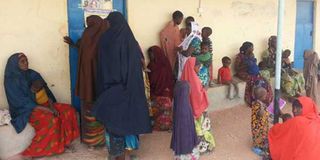Three killed by kala-azar as two hospitalised in Marsabit

Residents of Basil in Wajir County await screening for kala-azar at Basil health centre after an outbreak in the past. The disease has killed three people in the neighbouring Marsabit County. PHOTO | FILE | NATION MEDIA GROUP
What you need to know:
County director of public health Adano Kochi said that majority of the locals only go to hospital when the disease has advanced.
- He said that since fever is one of the symptoms, locals tend to first rely on traditional healing methods before deciding to go to hospital.
- Kala-azar symptoms include irregular bouts of fever, substantial weight loss, swelling of spleen and liver, and anaemia.
Three people have died of kala-azar in Marsabit County while two others are hospitalised at Marsabit Referral Hospital.
The county has been battling kala-azar since last year where more than five people lost their lives and more than 60 others were treated.
Speaking to the Nation on Thursday, county director of public health Adano Kochi said that in the past one week, three people have succumbed to the disease while two are still recuperating.
“One succumbed at Kenyatta National Hospital where he had been referred since he lacked platelets and hence his body could not control blood loss,” said Mr Adano.
TRADITIONAL HEALING
Mr Adano said that majority of the locals do not make use of health facilities and only get to the hospital when the disease has advanced.
He said that since fever is one of the symptoms, locals tend to first rely on traditional healing methods before deciding to go to hospital.
“Some come in for treatment late while others do not make it to the hospitals. Kala-azar is a disease we can control and avoid deaths but our people are still ignorant,” said Mr Adano.
The disease spreads quickly as a result of poverty in the areas along the Marsabit-Wajir boundary in both Laisamis and North Horr sub-counties.
Some of the affected areas include Shur, Gudhas, Hawaye, Loglogo and Baalar.
DOMESTIC ANIMALS
Kala-azar is transmitted by sand flies that bite and suck human blood.
The insects survive in tropical and temperate regions and Marsabit-Wajir border is a perfect environment for their growth and multiplication.
According to Mr Adano, the communities living in affected regions wear less clothes, sleep in open places and lack nets.
Mr Adano said living in poverty, without adequate sanitation and in close contact with infectious vectors and domestic animals creates increases chances of contracting the disease.
SWELLING SPLEEN
“In these communities due to poverty, even children are left to roam around naked hence making it easier for the flies when they attack. We have raised awareness and asked our people to sleep under nets since their houses are exposed,” added Mr Adano.
Kala-azar symptoms include irregular bouts of fever, substantial weight loss, swelling of spleen and liver, and anaemia and it is easy to mistake it for malaria.
Data from the Ministry of Health indicate that approximately 2,500 people are infected with the disease every year.
The disease is grouped under neglected tropical diseases, a group of communicable diseases that prevail in tropical and subtropical conditions in 149 countries.
According to the World Health Organisation, these diseases affect more than one billion people and cost developing economies billions of dollars every year.




